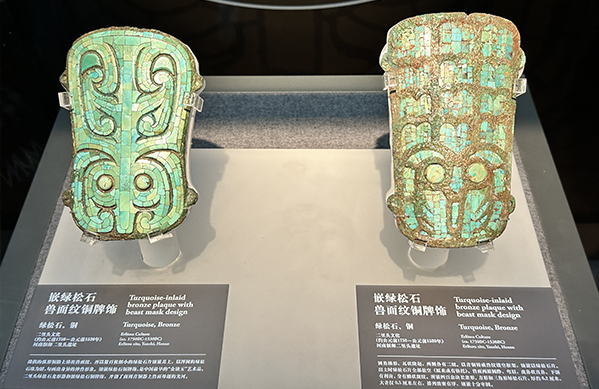Early cultural exchanges paved the way for the Xia Dynasty

Two turquoise-inlaid bronze plaques with beast mask design unearthed from Erlitou site Photo: Ren Guanhong/CSST
Approximately 5,000 years ago, as a result of global climate change, certain warm and humid regions in China underwent significant transformations, which led to a gradual and continuous decline in archaeological cultures in these areas. The Liangzhu culture, situated at the middle and lower reaches of the Yangtze River, gradually disappeared. Cultural influences shifted southward from present-day Shandong, while ancient cultures in present-day Guangdong, Zhejiang, and Fujian coastal areas expanded northward. The middle reaches of the Yellow River were also affected.
This widespread cultural transformation continued until around 4,500 years ago when a series of large city sites emerged in the Loess Plateau, the North China Plain, the Shandong Peninsula, and the plains around present-day Hunan and Hubei provinces. During this period, competition and conflicts intensified among different regional populations. Defensive structures such as rammed earth and stone walls were discovered at certain sites. Additionally, there was a significant increase in the number of special remains, such as “human buried in pits” and “human skulls buried in pits” [both were possibly human sacrifice]. Abundant remnants of weapons have also been found. The prehistoric cultural landscape in China underwent great changes, and northern China entered the Longshan Period [a Neolithic culture dating from about 2600 to 2000 BCE].
Early cultural exchanges
The Guanzhong Basin, located in the middle reaches of the Yellow River, was one of the core areas of the Longshan Period and the main distribution range of the Keshengzhuang culture [a cultural site at Xi’an, dating to the Longshan period]. The Taiping site [dating back about 4150–3700 years ago] in Xi’an is a high-ranking settlement of the Keshengzhuang culture, covering an area of over one million square meters, with its late period corresponding to the Xia Dynasty.
Artifacts unearthed at this site reveal extensive cultural interactions with the other regions. For example, polished black pottery cups may have connections with the Longshan culture in Henan. The hewa-style [shaped like a pair of combined tiles] pottery bells are similar in style to those from the Taosi site in Shanxi. Inscribed oracle bones may have originated from the Gansu-Qinghai region. Therefore, the Keshengzhuang culture represented by the Taiping site likely served as a center of regional cultural interactions during the Longshan period.
Studies show that such frequent and widespread cultural interactions also occurred in neighboring areas. Long-term absorption of civilizational elements from surrounding regions brought about further changes in the social structure of the Central Plains. Increasing wealth disparity, growing social stratification, and the gradual concentration of power eventually gave rise to armies and military leaders, leading to the dissolution of the abdication system and the emergence of kingship. As a result, the Central Plains witnessed the emergence of a powerful centralized ruling class and the birth of the first wide-ranging kingdom in Chinese history, the Xia Dynasty.
Blending cultural elements
The Xia culture was composed of early Xinzhai and the late Erlitou cultures, which originated from the cultural traditions of the Longshan Period. It also assimilated numerous cultural factors from other regions.
A large number of jade objects with various designs have been unearthed at the Erlitou cultural sites. The use of jade in the Guanzhong Basin was not common prior to the Longshan period. Several woodworking tools made from jade from the Yangshao period were most likely used as production tools. During the Keshengzhuang period, jade axes with unsharpened blades and no signs of wear began to appear, possibly serving as symbols of wealth and power. At the same time, ritual objects such as cong [cylindrical jade ornaments] and bi [disc-shaped jade objects] related to sacrificial rituals also emerged. The Taiping site yielded numerous jade ritual objects, processing scraps, and unprocessed jade. These represent a complete chain of jade processing, indicating the existence of jade workshops at the site.
More than 5,000 years ago, during the late period of the Yangshao culture, there existed a certain degree of “close connection” between different regions of prehistoric China. Similar cosmology, astronomy, calendar systems, and funeral rites were widely disseminated. For example, several jade yue [ceremonial axe], a symbol of power that evolved from tools or weapons, have been found in large tombs across different regions. The widespread presence of large-mouthed jars in tombs from the lower reaches of the Yellow River to the middle and lower reaches of the Yangtze River may reflect similar funerary rituals in ancient times.
The late Longshan era was an important period for the formation of the Xia. The emergence of the Xia should be interpreted within the broader context of extensive cultural interactions during this period. The Erlitou culture, located in the Central Plains, widely absorbed cultural elements from various regions, while exerting its cultural influence outwardly, becoming a “strong culture with centripetal and radiating power.”
Shen Baiming is a research assistant from the Institute of Archaeology at CASS.
Edited by REN GUANHONG
